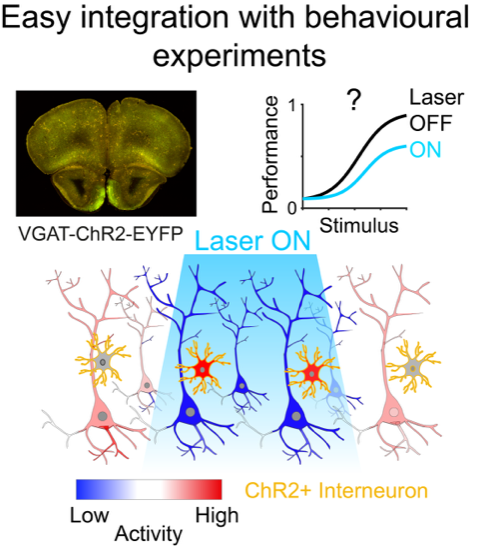
Zapit: democratising random-access optogenetics
By April Cashin-Garbutt
Optogenetic tools have become vital in neuroscience. By shining light into the brain, neuroscientists can transiently turn neurons on and off to elucidate the causal mechanisms underlying animal behaviour. Traditionally thin optical fibres have been used to deliver light into specific parts of the brain. And while a lot has been learned from this technique, there are several limitations to using optical fibres to deliver light, including that they cannot easily be moved once implanted.
Researchers at the Sainsbury Wellcome Centre came up against this problem during an experiment where the outcome they expected was seen in some animals but not others. They suspected this was because the fibre placement across different mice was variable, leading to differences in experimental effect. The researchers worked closely with the Advanced Microscopy team at SWC to develop a ‘random-access’ system capable of stimulating a wider selection of neurons close to each other. The system they developed, called Zapit, consists of a focused beam of light that can be directed across the entire cortex of the mouse brain very quickly using a pair of scan mirrors.
“Zapit solves two problems. Firstly, you can stimulate any bit of mouse cortex on the dorsal surface that you like, and you can stimulate multiple areas in close succession. This means you can do more than one experiment in the same animal. Secondly, the system democratises access to this technique, as there is currently no option that you can purchase and the published papers using similar approaches do not provide sufficient detail for non-experts to build a system,” explained Dr Rob Campbell, Head of Advanced Microscopy at SWC and corresponding author on the bioRxiv preprint.
Optic fibres versus random-access laser scanning optogenetics
In optogenetic experiments, thin optical fibres are typically implanted in the brain to deliver light to specific areas. Whereas random-access laser scanning optogenetic systems do not require anything to be permanently implanted in the brain. The systems make use of transgenic expression of optogenetic actuators in genetically defined subpopulations of neurons.
However, it can be challenging to build such random-access systems as they require optical, programming, and data acquisition knowledge. The systems also require animals to be head-fixed.

Developing a shareable solution
Dr Campbell worked together with researchers at SWC to develop a user-friendly solution. The new system, called Zapit, works by targeting locations based on an atlas of brain areas.
“Zapit is effectively a programmable laser pointer for switching on and off brain areas in the cortex to understand what role they play in behaviour. Users are able to select areas of the brain from a brain atlas, and then choose how many spots the beam of light targets one after the other. They can then use a simple programming interface to integrate with their behavioural experiments,” explained Dr Campbell.
The system is open source and the team have shared a full parts list, CAD drawing, and user-friendly software installation guidelines on GitHub. They are also available to contact for anyone who wishes to seek help in setting up Zapit.

Implications of Zapit
Zapit has already been used by a number of researchers at SWC including Sir Henry Wellcome Postdoctoral Fellow, Dr Michael Lohse and Research Fellow, Dr Oliver Gauld, who were instrumental in developing the system.
“Using Zapit to inactivate multiple cortical areas in the same behavioural session, we have been able to identify areas in frontal cortex located in close proximity that serve completely different behavioural functions. This has allowed us to uncover new parallel cortico-basal ganglia circuits subserving distinct behavioural subcomponents during decision-making,” explained Dr Lohse.
“We have recently started experiments using Zapit to causally investigate the spatiotemporal flow of information across the cortex during economic decision-making,” commented Dr Gauld.
The team hope that the system will continue to enable researchers to carry out more complex experiments. “Zapit helps to reduce the number of animals needed for experiments as it takes away the potential problem of optical fibre misplacement and allows researchers to stimulate multiple areas of the cortex in the same animal,” commented Dr Campbell.
Next steps for Zapit
The next steps for the team are to carry out a greater range of validation experiments to demonstrate the effects of Zapit stimulation on neural activity. This will include electrophysiological verification experiments using Neuropixels probes. They are also looking to validate the accuracy of the overlaid brain map.
The team would like to encourage Zapit users to report parameters, such as laser power, to aid the community to replicate experiments and enable consistency across labs. Further details on reporting recommendations are available in the discussion section of the bioRxiv preprint.
About Zapit
To find out more about Zapit:
- Read the preprint in bioRxiv: ‘Zapit: Open Source Random-Access Photostimulation For Neuroscience’
- Access Zapit parts list and code on GitHub: Zapit Optostim
- Contact Rob Campbell for more information


